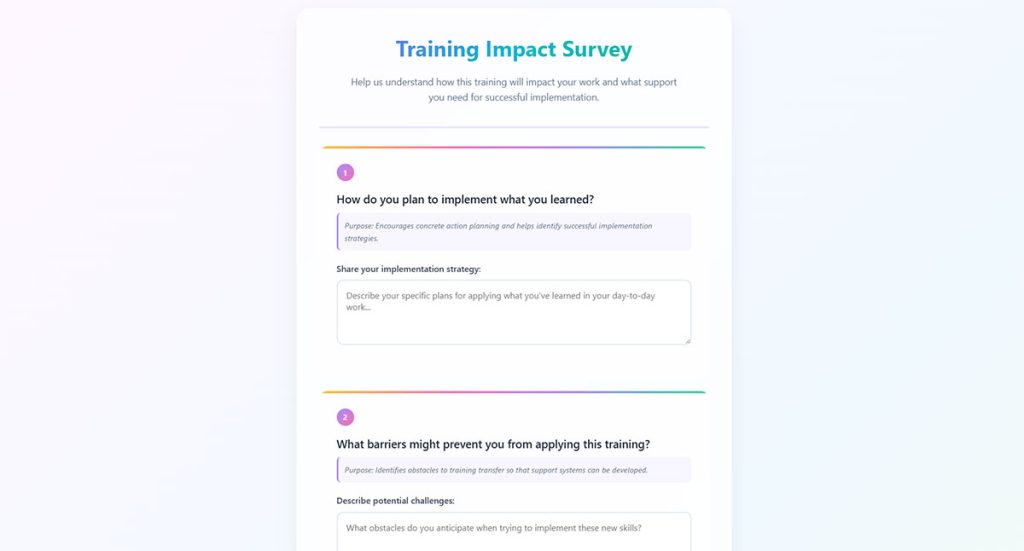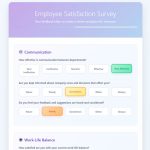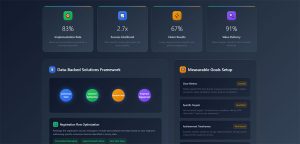You send a survey. Half your audience ignores it. The other half quits halfway through. Sound familiar? Survey fatigue is killing your response rates and destroying data quality. When participants…
Table of Contents
Better training starts with asking better questions. Training survey questions unlock insights that transform your learning programs from good to exceptional.
Companies waste millions on ineffective training annually. Without proper employee feedback questionnaires, you’re flying blind.
Every training evaluation needs the right questions to measure what actually matters. Whether you’re assessing skill development, knowledge retention, or program satisfaction, the questions you ask determine the quality of your insights.
This article breaks down essential training survey questions across five key categories. You’ll discover:
- Pre-training assessment questions
- Real-time engagement metrics
- Post-training effectiveness measures
- Long-term impact evaluations
- Instructor performance indicators
Learn which question types yield actionable insights and how to structure your training feedback forms for maximum response rates. Stop guessing at what works. Start measuring real training impact.
Training Survey Questions
Overall Training Evaluation

Overall Quality Rating
Question: How would you rate the overall quality of this training program?
Type: Multiple Choice (1–5 scale from “Poor” to “Excellent”)
Purpose: Provides a comprehensive assessment of the entire training experience and serves as a key performance indicator for program success.
When to Ask: At the end of the training program during the final evaluation survey.
Expectation Alignment
Question: To what extent did this training meet your expectations?
Type: Multiple Choice (1–5 scale from “Did not meet expectations at all” to “Exceeded expectations”)
Purpose: Measures the gap between participant expectations and actual training delivery to identify areas for improvement in marketing and content design.
When to Ask: During the post-training evaluation, ideally within 24-48 hours of completion.
Recommendation Likelihood
Question: Would you recommend this training to a colleague?
Type: Multiple Choice (Yes/No or 1–10 Net Promoter Score scale)
Purpose: Gauges participant satisfaction and identifies training advocates who can help promote future programs through word-of-mouth.
When to Ask: In follow-up surveys 1-2 weeks after training completion when participants have had time to reflect.
Application Intent
Question: How likely are you to apply what you learned in your day-to-day work?
Type: Multiple Choice (1–5 scale from “Very unlikely” to “Very likely”)
Purpose: Predicts training transfer and helps identify potential barriers to implementation before they occur.
When to Ask: Immediately after training and again in follow-up surveys 30-60 days later to track changes in intent.
Content and Relevance

Job Relevance
Question: How relevant was the training content to your job responsibilities?
Type: Multiple Choice (1–5 scale from “Not relevant at all” to “Extremely relevant”)
Purpose: Ensures training content aligns with participant needs and helps identify content that may need updating or customization.
When to Ask: During mid-training check-ins and final evaluations to capture both immediate and overall impressions.
Difficulty Appropriateness
Question: Was the difficulty level of the material appropriate for your experience level?
Type: Multiple Choice (“Too basic,” “Just right,” “Too advanced”)
Purpose: Helps calibrate content difficulty and identify when different skill level tracks or prerequisites might be needed.
When to Ask: During training breaks and in post-training surveys to allow participants time to process the material.
Most Valuable Topics
Question: Which topics were most valuable to you and why?
Type: Open-ended with optional ranking of topics
Purpose: Identifies high-impact content areas that should be emphasized in future training and helps prioritize curriculum development efforts.
When to Ask: At the end of each training module and in comprehensive post-training evaluations.
Content Gaps
Question: Were there any topics you felt were missing or needed more coverage?
Type: Open-ended
Purpose: Reveals curriculum gaps and opportunities for program expansion or refinement based on participant expertise and needs.
When to Ask: During final evaluations when participants have experienced the full program scope.
Learning Objective Alignment
Question: How well did the training content align with your learning objectives?
Type: Multiple Choice (1–5 scale from “Poor alignment” to “Perfect alignment”)
Purpose: Measures whether the training delivered on its promised outcomes and helps refine objective-setting for future programs.
When to Ask: Post-training, after participants have had time to compare their initial goals with actual outcomes.
Instructor/Facilitator Effectiveness

Subject Matter Expertise
Question: How would you rate the instructor’s knowledge of the subject matter?
Type: Multiple Choice (1–5 scale from “Poor” to “Excellent”)
Purpose: Evaluates instructor credibility and identifies needs for additional subject matter training or expert guest speakers.
When to Ask: During mid-training evaluations and final assessments to capture sustained impressions of expertise.
Presentation Effectiveness
Question: How effectively did the instructor present the material?
Type: Multiple Choice (1–5 scale from “Very ineffective” to “Very effective”)
Purpose: Assesses instructional delivery skills and helps identify areas for instructor development or coaching.
When to Ask: After each major training session and in comprehensive post-training evaluations.
Participation Encouragement
Question: Did the instructor encourage participation and answer questions clearly?
Type: Multiple Choice (1–5 scale from “Strongly disagree” to “Strongly agree”)
Purpose: Measures the instructor’s ability to create an engaging, interactive learning environment and provide clear explanations.
When to Ask: During training breaks and final evaluations to capture the full range of interaction experiences.
Pace Management
Question: How well did the instructor manage the pace of the training?
Type: Multiple Choice (“Too slow,” “Just right,” “Too fast”)
Purpose: Identifies pacing issues that can significantly impact learning effectiveness and participant engagement.
When to Ask: At the end of each training day for multi-day programs, or during natural breaks in single-day sessions.
Training Methods and Materials
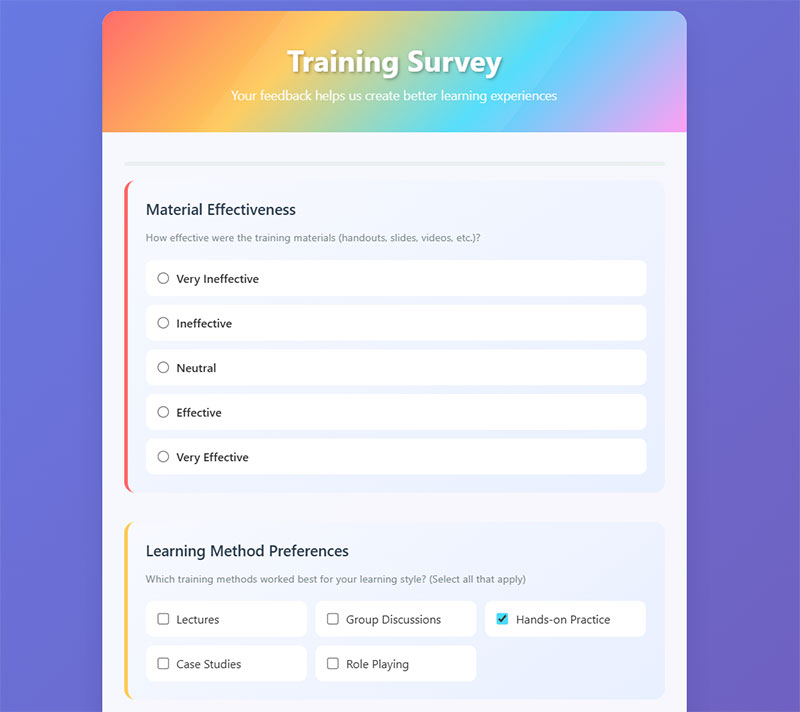
Material Effectiveness
Question: How effective were the training materials (handouts, slides, videos, etc.)?
Type: Multiple Choice (1–5 scale from “Very ineffective” to “Very effective”)
Purpose: Evaluates the quality and utility of supporting materials to guide future resource development and procurement decisions.
When to Ask: During training sessions when materials are fresh in participants’ minds and in post-training follow-ups.
Learning Method Preferences
Question: Which training methods worked best for your learning style?
Type: Multiple Choice with options like “Lectures,” “Group discussions,” “Hands-on practice,” “Case studies,” “Role playing”
Purpose: Identifies preferred learning modalities to optimize future training design and accommodate diverse learning preferences.
When to Ask: After experiencing multiple training methods, typically mid-way through and at the end of the program.
Activity Helpfulness
Question: Were the hands-on activities and exercises helpful?
Type: Multiple Choice (1–5 scale from “Not helpful at all” to “Extremely helpful”)
Purpose: Measures the effectiveness of experiential learning components and guides decisions about activity inclusion and design.
When to Ask: Immediately after major activities and in comprehensive post-training evaluations.
Technology Usage
Question: How would you rate the use of technology during the training?
Type: Multiple Choice (1–5 scale from “Poor” to “Excellent”)
Purpose: Assesses whether technology enhanced or hindered the learning experience and identifies areas for technical improvement.
When to Ask: During training sessions when technical experiences are recent and in final evaluations for overall assessment.
Learning Outcomes
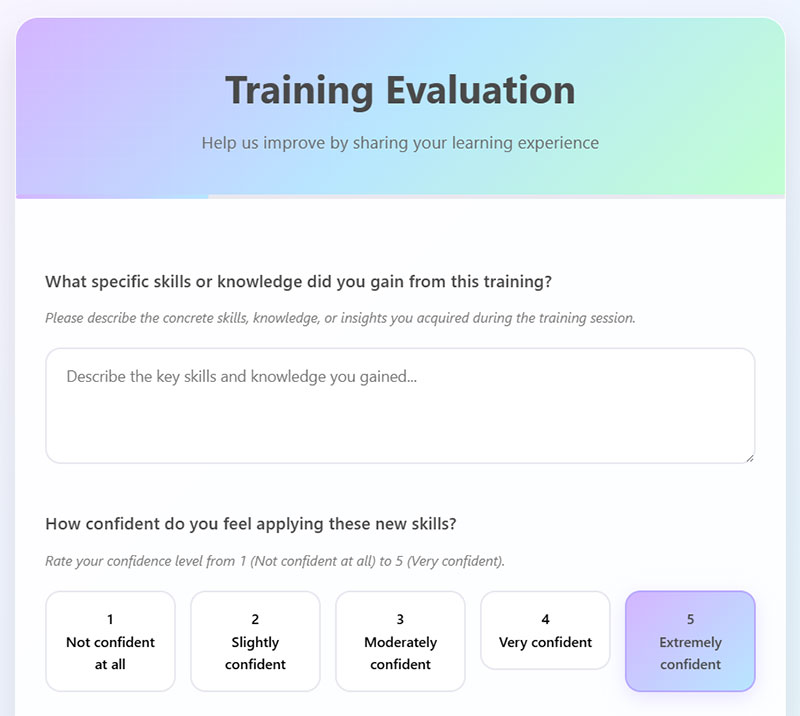
Skills and Knowledge Gained
Question: What specific skills or knowledge did you gain from this training?
Type: Open-ended
Purpose: Captures concrete learning outcomes and helps demonstrate training ROI while identifying successful curriculum elements.
When to Ask: Immediately post-training and in follow-up surveys to track retention and application of learning.
Application Confidence
Question: How confident do you feel applying these new skills?
Type: Multiple Choice (1–5 scale from “Not confident at all” to “Very confident”)
Purpose: Measures self-efficacy and predicts successful skill transfer while identifying areas where additional support may be needed.
When to Ask: At training completion and in follow-up surveys to track confidence changes over time.
Key Learning Insight
Question: What was the most important thing you learned?
Type: Open-ended
Purpose: Identifies the highest-impact learning moments and helps prioritize core curriculum elements for future training design.
When to Ask: During training wrap-up sessions and in post-training reflection surveys.
Unmet Learning Objectives
Question: Which learning objectives do you feel were not adequately addressed?
Type: Multiple Choice list of stated objectives plus open-ended option
Purpose: Identifies curriculum gaps and helps refine learning objectives to ensure they are achievable and measurable.
When to Ask: In post-training evaluations after participants have had time to reflect on the complete learning experience.
Logistics and Environment
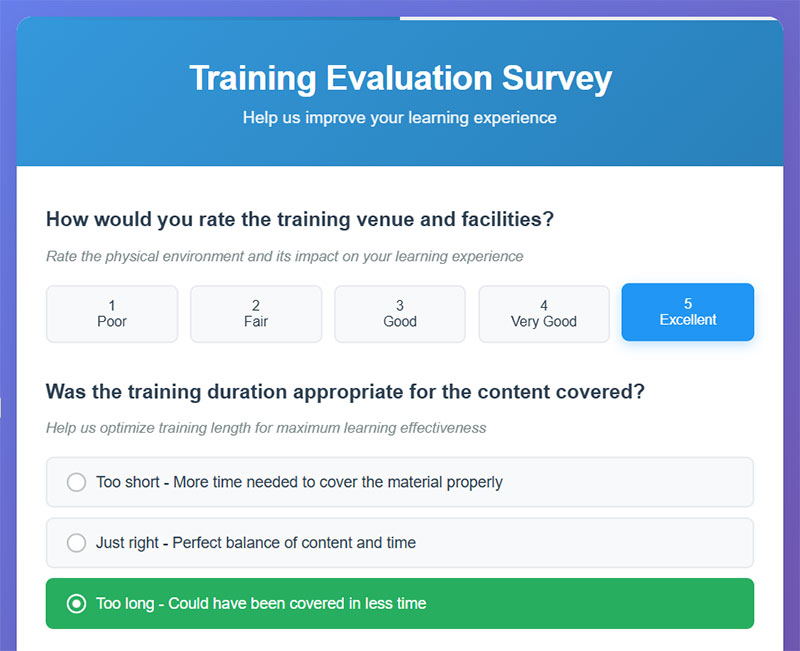
Venue and Facilities Rating
Question: How would you rate the training venue and facilities?
Type: Multiple Choice (1–5 scale from “Poor” to “Excellent”)
Purpose: Evaluates whether the physical environment supported or hindered learning and informs future venue selection decisions.
When to Ask: During training sessions and in post-training evaluations to capture both immediate and overall impressions.
Duration Appropriateness
Question: Was the training duration appropriate for the content covered?
Type: Multiple Choice (“Too short,” “Just right,” “Too long”)
Purpose: Helps optimize training length to maximize learning while respecting participant time constraints and attention spans.
When to Ask: At the end of training sessions and in follow-up surveys when participants can better assess content-to-time ratios.
Schedule Convenience
Question: How convenient were the training dates and times?
Type: Multiple Choice (1–5 scale from “Very inconvenient” to “Very convenient”)
Purpose: Identifies scheduling barriers that might affect attendance and participation quality in future training offerings.
When to Ask: During registration follow-up and post-training evaluations to inform future scheduling decisions.
Technical Issues Impact
Question: Were there any technical issues that interfered with your learning?
Type: Yes/No with open-ended follow-up for details
Purpose: Identifies technology-related barriers to learning and helps prioritize technical infrastructure improvements.
When to Ask: During training sessions when issues occur and in post-training surveys for comprehensive technical assessment.
Future Training Needs

Additional Training Topics
Question: What additional training topics would be beneficial for you?
Type: Open-ended with optional multiple choice list of potential topics
Purpose: Identifies future training opportunities and helps build a pipeline of relevant programs that meet ongoing participant needs.
When to Ask: In post-training surveys and periodic needs assessment surveys throughout the year.
Preferred Training Format
Question: What format would you prefer for future training sessions?
Type: Multiple Choice (“In-person,” “Virtual/online,” “Hybrid,” “Self-paced,” “Microlearning”)
Purpose: Guides training delivery method selection to optimize accessibility, engagement, and cost-effectiveness.
When to Ask: In post-training evaluations and periodic preference surveys to track changing format preferences.
Training Frequency Preference
Question: How often would you like to receive training on this topic?
Type: Multiple Choice (“One-time only,” “Annually,” “Semi-annually,” “Quarterly,” “As needed”)
Purpose: Helps plan training cycles and refresh schedules to maintain skill currency without causing training fatigue.
When to Ask: In post-training surveys and follow-up assessments when participants can better judge their ongoing learning needs.
Advanced Training Interest
Question: Are there specific areas where you need more advanced training?
Type: Open-ended with optional skill level assessment
Purpose: Identifies opportunities for advanced or specialized training tracks and helps create learning pathways for skill development.
When to Ask: In post-training evaluations and periodic skill gap assessments throughout the year.
Impact and Application
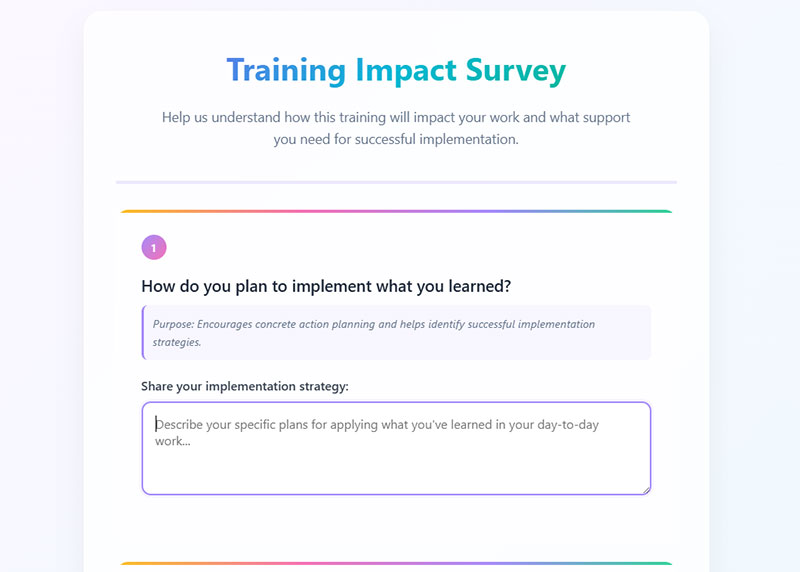
Implementation Planning
Question: How do you plan to implement what you learned?
Type: Open-ended
Purpose: Encourages concrete action planning and helps identify successful implementation strategies that can be shared with future participants.
When to Ask: At the end of training sessions and in 30-day follow-up surveys to track implementation progress.
Implementation Barriers
Question: What barriers might prevent you from applying this training?
Type: Open-ended with optional multiple choice list of common barriers
Purpose: Identifies obstacles to training transfer so that support systems and resources can be developed to overcome them.
When to Ask: Immediately post-training and in follow-up surveys to capture both anticipated and actual barriers.
Performance Impact Expectation
Question: How will this training help improve your job performance?
Type: Open-ended
Purpose: Connects training outcomes to business results and helps demonstrate ROI while identifying areas where impact measurement is needed.
When to Ask: In post-training evaluations and follow-up surveys to track both expected and actual performance improvements.
Support Needs
Question: What support do you need to successfully apply these skills?
Type: Open-ended with optional multiple choice list of support options
Purpose: Identifies post-training support requirements and helps design follow-up resources, coaching, or reinforcement programs.
When to Ask: At training completion and in follow-up surveys to ensure ongoing support aligns with actual implementation challenges.
FAQ on Training Survey Questions
What types of questions work best for training evaluation?
Mix quantitative feedback with qualitative responses. Use Likert scale questions for quick ratings. Add open-ended questions for detailed insights. Multiple choice formats capture specific data points. Balance structured questions with free-form feedback to get complete participant engagement metrics.
How many questions should a training survey include?
Keep it under 15 questions. Longer surveys hurt response rate optimization. Focus on essential metrics. Group similar topics together. Use conditional logic to show relevant questions. Short surveys get better completion rates. Quality beats quantity for actionable insights.
When should training surveys be administered?
Deploy at three key moments. Send pre-training questionnaires before sessions start. Use mid-training pulse checks. Conduct post-training evaluation within 24 hours. Add follow-up surveys after 30-60 days to measure knowledge retention and behavioral change.
What’s the best format for online training feedback?
Digital survey form formats work best. Mobile-friendly designs increase participation. Use progress bars. Keep pages short. Enable anonymous submissions for honest feedback. Auto-save features prevent data loss. Make surveys accessible across all devices.
How do you measure training effectiveness?
Track multiple evaluation metrics. Compare pre and post scores. Monitor skill application rates. Measure performance improvements. Calculate training ROI. Use Kirkpatrick model levels. Document behavioral changes. Link results to business outcomes. Create benchmarking data for comparison.
What makes a good training satisfaction questionnaire?
Focus on specific experiences. Ask about content relevance. Evaluate delivery methods. Rate instructor effectiveness. Assess learning objectives achievement. Include improvement suggestions sections. Keep language simple. Use consistent rating scale items throughout the survey.
How can you improve survey response rates?
Send personalized invitations. Set clear deadlines. Offer incentives. Keep surveys short. Explain survey purpose. Share results later. Use survey distribution timing wisely. Send reminders. Make participation easy. Show how feedback creates continuous improvement.
What questions assess long-term training impact?
Ask about skill development application. Measure workplace behavior changes. Track performance indicators improvements. Evaluate knowledge transfer to teams. Document business impact. Compare current vs past performance. Focus on organizational development outcomes. Include manager observations.
How do you create accessible training surveys?
Follow form accessibility guidelines. Use clear labels. Provide alternative text. Ensure keyboard navigation. Test screen reader compatibility. Choose high-contrast colors. Write simple instructions. Avoid technical jargon. Make web forms inclusive for all users.
What’s the difference between evaluation and feedback forms?
Training evaluation forms measure specific outcomes. They track learning objectives achievement. Focus on quantifiable results. Feedback forms gather opinions and experiences. They capture subjective impressions. Combine both for comprehensive training assessment. Each serves distinct measurement purposes.
Conclusion
Effective training survey questions transform your workplace learning initiatives from guesswork to data-driven success. They bridge the gap between training delivery and actual performance management outcomes.
Your learning and development team now has the tools to create comprehensive evaluation instruments. Remember these key principles:
• Start with clear training goals
• Balance question types for complete insights
• Time surveys strategically
• Focus on continuous learning culture
• Track both immediate and long-term impact
Modern WordPress survey plugins simplify the entire process. From survey templates to automated data analytics, the right tools make feedback collection effortless.
Success depends on asking the right questions at the right time. Whether measuring instructor evaluation, tracking learning outcomes, or calculating training budget ROI, your surveys drive organizational change.
Transform your training programs today. Better questions lead to better learning experiences. Start building surveys that deliver the improvement metrics your organization needs.


